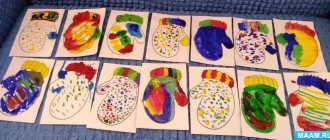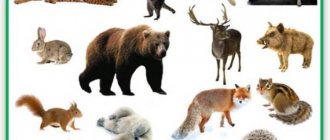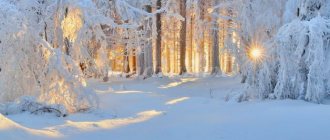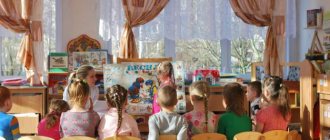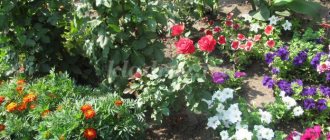Conversation with children of the preparatory group. Wild animals in winter
Summary of educational activities for the implementation of the educational program “Cognitive Development” for children with special needs in the preparatory group, conversation on the topic “Wild animals in winter”
Author: Fomina Irina Aleksandrovna, teacher of MBDOU “Kindergarten of compensatory type No. 21”, Snezhinsk, Chelyabinsk region Description of work: I offer a summary of the educational activity with children of the preparatory group “Wild Animals in Winter”. This development will be of interest to teachers of correctional preschool institutions who work with children with speech disorders. Objectives: Educational area “Cognitive development” • Continue to consolidate children’s knowledge about the appearance of wild animals, their habits, food, and housing.
• Be able to distinguish between predatory and herbivorous animals. • Expand understanding of the peculiarities of animal adaptation to the environment. Educational area “Speech development” • Activate the vocabulary on this topic • Continue teaching children to answer questions, encourage them to participate in the conversation. • Develop explanatory speech when solving riddles. Educational field “Social and communicative development” Foster love and respect for native nature. Educational area “Physical development” • Develop fine and gross motor skills through finger gymnastics and physical exercises. Course of direct educational activities
1. Organizational moment. Game “Guess by Description” Educator: - The one who answers correctly will sit.
Educator: - Who is this? Cowardly, long-eared, gray or white? Children: - Hare Teacher: - Brown, clubfooted, clumsy? Children: - Bear Educator: - Gray, angry, hungry? (how did you guess?) Children: - Wolf Educator: - Cunning, red-haired, dexterous? Children: - Fox Educator: - Agile, thrifty, red or gray? Children: - Squirrel Teacher: - A pillow with needles lay between the trees. She lay quietly, then suddenly ran away. Children: - Hedgehog 2. Main part.
Educator: - How can you call them all, in one word? Children: - Animals. Educator: - Why? Children: - Body covered with hair, 4 legs, torso, muzzle, tail. Educator: - Where do these animals live? Children: - In the forest Teacher: - What are they called? Children: - Wild animals Educator: - Why are they called that? Children: - They get their own food. Educator: - What else are they called? Children: - Animals Educator: - Guys, we have already talked about how nature changes in winter, we talked about the signs of winter. But animals are also part of nature. This means that changes are happening to them too. But we’ll find out what they are now. Educator: - Who can we meet in the winter forest, you will find out by guessing the riddle. You and I recognize the animal by these two signs: He wears a gray fur coat in the winter, And he wears a red fur coat in the summer. (Squirrel) Educator: - That's right, it's a squirrel. Why do you think she changes the color of her coat in winter? Yes, so that it would be easier for her to hide from her enemies, such as hawks and martens. In winter, the trees stand without leaves, and against the background of dark gray branches and trunks, the gray squirrel coat is less noticeable than if it were red. In addition to the fact that the squirrel fur coat changes color, it also becomes warmer. And in the most severe frosts the squirrel sleeps in its home, who knows what it is called? Children: - Hollow Teacher: - It is also prepared for winter: in the fall, the squirrel dragged fallen leaves and dry moss into it, so that the hollow is dry, warm and soft. Educator: - The squirrel is a big fuss and a hard worker. She prepared not only a warm hollow for winter. Do you know what else? Of course, the supplies that the squirrel eats all winter. In summer and autumn, she collects nuts and acorns, dries mushrooms and stores all this in special storage rooms - in empty hollows, under moss, near old stumps. She also collects spruce and pine cones and feeds on their seeds. So the squirrel does not have to starve in winter. Educator: - Which other forest dwellers change the color of their fur coat for winter? Children: - Hare. Educator: - That's right, hare. In the summer, what color was it? Children: - Gray Teacher: - And by winter it gradually turns white: first the tail becomes white, then the hind legs, and only then the back and sides turn white. Remember how we talked about how everything in nature has its cause? Why do you think a hare needs a white coat? (Children express their opinions.) And the hare is also helped by his fast legs. His hind legs are very strong, the hare pushes off with them and makes big jumps, running away from his enemies - the fox and the wolf. Educator: - How does a hare arrange a house for itself? Educator: - It turns out that he does not have a separate mink. On a winter day, he usually sleeps in a snow hole or buried in a snowdrift, and at night he goes out to get food: gnaw the bark of fallen trees. Educator: - Listen and guess whose voice this is? Children: - This is a fox Educator: - The fox is also preparing for winter. In winter, thick fur grows on its paws so that it is not cold to step on the snow. The fox walks as if wearing felt boots. Educator: - Does anyone know why the fox has such a big fluffy tail? Educator: - The long tail serves as a rudder for the fox, helping to abruptly change the direction of its run during the hunt. Educator: — The white tip of the mother fox’s tail is a guide for the fox cubs at night. Seeing him like a beacon, they unmistakably follow her. In winter, in bitter frosts, the tail serves as a warm fluffy blanket and a soft pillow for the fox. She curls up in her hole, covers her paws with her tail and lies with her muzzle buried in the delicate fur. Warm and cozy. Educator: - Listen to another voice. Educator: - Who is this? Children: - Wolf. Educator: - Although the wolf does not change his fur coat, he insulates it. By winter, wolf fur becomes thicker and longer. Wolves need this, because they sleep right in the snow, covering their nose and paws with their tail. They usually sleep during the day and hunt at night. But in winter, wolves gather in packs and walk in a chain, one after another, in search of prey - this makes it easier to hunt. In a wolf pack there is a leader - a strong, intelligent, experienced wolf. The whole pack of wolves hunts deer, elk, and wild boar. And in severe frosts, when all the animals are hidden, wolves can approach people’s homes. They can drag away a piglet, a sheep, or attack a calf. Educator: - And during the day they hide in their den. Where are they hiding? Children: - In the den Educator: - But there are still interesting wild animals that we haven’t talked about yet. Maybe you can name them for me? This is how animals don’t dig holes, but they build dams. They are all dressed in fur coats. Tools are not saws-teeth. Educator: - The beavers’ dwelling is called so interestingly - a hut. Educator: - They build this dwelling themselves from fallen trees on reservoirs. The entrance to the hole is under water, and the hole itself is a complex structure with several entrances and exits, many holes and nesting chambers. Beavers are very clean. Educator: - What are beaver cubs called? Children: - Beavers. Educator: - Guys, but in the forest you can meet another animal, look at the slide, you will recognize it. Educator: - This is a badger, look what a big family he has. Badger mother, badger cubs. They live in a hole; badgers are very ambitious animals. They feed on insects, larvae, and worms. Didactic game “Cut pictures” Educator: - In the forest you can also meet a very unusual animal. Educator: - Elk is the largest relative of deer. The length of its body reaches up to 3 meters. Educator: - Does anyone know why moose have antlers? Children: - They serve for defense against predators. Educator: - Look carefully, what does the moose have on its legs? Children: - Hooves Teacher: - they help him move through the snowy forest, like on skis, he doesn’t fall through.
Physical exercise.
Educator: - But what animals cannot be found in the forest in winter? Educator: - Why? Educator: - The bear carefully and skillfully prepares his den: he covers it with fallen leaves, soft fragrant pine needles, and dry moss. As soon as snowflakes fly from the sky, the bear goes to bed. A blanket of snow will cover the den on top, and the home will become warm. His sleep will last until spring. Educator: - But the hedgehog also does not make supplies for the winter. When the cold comes, he climbs into his warm and cozy house and sleeps soundly until spring. The white snow will cover the hole with a blanket, and no one will find or disturb the hedgehog. Maybe the hedgehog will dream about how he wandered through the forest in the summer, catching worms, beetles, nimble lizards, poisonous snakes, mice and frogs. Do you remember your hedgehog's favorite treats? Educator: - And now I suggest you collect pictures. Educator: - Let's move your animals to their homes. Educator: - Where does the wolf live? Children: - In the den Educator: - Who does he live with? Children: - With wolf cubs. (for each animal)
Bottom line
Educator: - Who did we talk about today? - Why are they called wild? —Who hibernates in winter? -Name the home of wild animals? — What else interesting did you learn?
We recommend watching:
Entertainment scenario for senior and preparatory groups. Journey to the land of fairy tales and mysteries Game program for the preparatory group of a kindergarten Synopsis of a game lesson in English with preschoolers on the topic “May Day” Entertainment scenario for children of the preparatory group for school
Similar articles:
Dramatization of the Russian folk tale in kindergarten “Masha and the Bear”
Playful musical entertainment for children of the preparatory group in kindergarten. Scenario
Spring leisure in the preparatory group. Semik - Russian rite of flowering
Fun in the preparatory group. Russian customs
Fun game for children in the preparatory group of kindergarten
